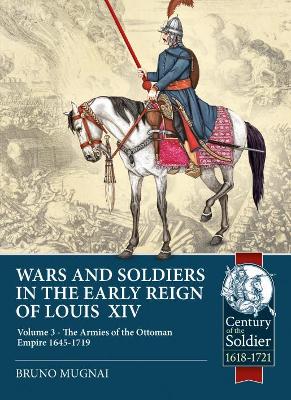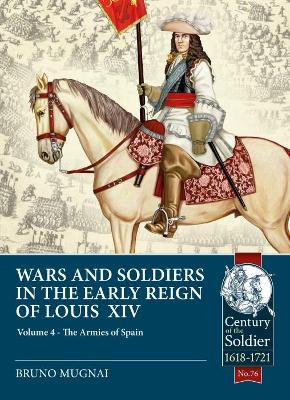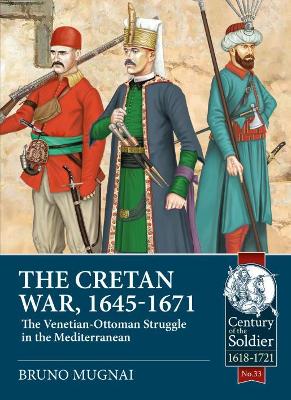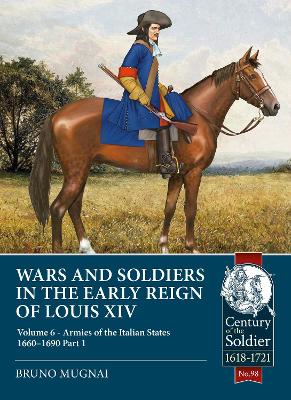Century of the Soldier
6 total works
Prolific Italian artist and author, Bruno Mugnai introduces the Dutch Army of the third quarter of the 17th century in the first of a new 8 volume series that covers the armies of early years of Louis XIV reign. France and the United Provinces represented opposite models of state government during the 17th century. The contrary nature of their political structure led to conflict on several occasions during this period. Military Historians have focused research onto the final phase of the conflicts such as the Wars of the Grand Alliance and the Spanish Succession, which coincides with the beginning of the long decline for both countries. Mugnai examines the evolution of the Dutch Army, its equipment, weapons and tactics, along with its uniforms and flags and ensigns. The book is lavishly illustrated and contains 8 specially commissioned colour plates that depicts the Army of United Provinces during the nation's 'Golden Age'.
Conflicts between Christian powers and the Ottoman Empire displayed completely different characteristics compared to other contemporary wars fought in Europe, war without mercy being the norm. The tones adopted by Western literature to describe the Ottomans resemble the ones recently used against the communist bloc and the Soviet Union, and it is probably not a coincidence that certain prophecies about the sultan, such as his arrival in Rome and watering the horse in San Pietro, survived until the post-1945 period, replacing the Grand Turk with the Red Army's Cossacks.
This book deals with the organization, the composition and the history of the army of the Sublime Porte, starting from the information contained in Western sources. This approach, despite the partial origin of the information, allows a critical examination of the sources and the formulation of a vision that is not conditioned by the cliches that often occur about such topics, returning us to a a neutral vision of the complex Ottoman 'Military' represented with all its refined and sumptuous costumes and weapons apparatus.
A larger part of the work is dedicated to the different types of clothing and insignia of the different corps, their evolution and the meaning of the different symbols.
This book deals with the organization, the composition and the history of the army of the Sublime Porte, starting from the information contained in Western sources. This approach, despite the partial origin of the information, allows a critical examination of the sources and the formulation of a vision that is not conditioned by the cliches that often occur about such topics, returning us to a a neutral vision of the complex Ottoman 'Military' represented with all its refined and sumptuous costumes and weapons apparatus.
A larger part of the work is dedicated to the different types of clothing and insignia of the different corps, their evolution and the meaning of the different symbols.
Wars & Soldiers in the Early Reign of Louis XIV Volume 4
by Bruno Mugnai
Published 30 September 2021
It has been a commonly held historical belief that in the second half of the 17th century, the Spanish army suffered such catastrophic defeats that it effectively brought about the collapse of the state as a major player on the European stage. The wars, fought out in Catalonia, Franche Comte, Flanders and Italy, resulted in a series of substantial defeats for Spain. The forces of Louis XIV carried all before them. Spain's ability to fend off the French monarch's assault was not eased by the fact that, at the same time, Spain had faced the Portuguese in the Iberian Peninsula, the English in the Caribbean, the Algerians in Melilla, as well as further insidious French assault in southern Italy and in the colonies. In this regard, it would be more correct to consider this age as a period of resilience, rather than military defeats. Equally superficially, the Portuguese War of Independence too was considered as a peripheral conflict of minor interest, while it also involved France and England in addition to the countries directly concerned.
The story, organisation, uniforms and equipment of the Spanish and Portuguese armies of this age are dealt for the first time in a single book, after archive's sources and unpublished iconography.
The story, organisation, uniforms and equipment of the Spanish and Portuguese armies of this age are dealt for the first time in a single book, after archive's sources and unpublished iconography.
A considerable part of the military history of the 17th century is dominated by the conflict between the Christian powers and the Ottoman Empire. Much has been written about the politics and the campaigns that led to the siege of Vienna in 1683 and the defeat suffered by the Sultan's armies, while, until today, there are relatively few studies on the long war that opposed Venice to the Ottoman Empire. The importance of the event in the context of politics not only of the Mediterranean, but of all Europe, is easily found in the number of chancelleries involved in the war, both directly on the battlefield or in diplomatic negotiations. The strategic duel involved the belligerents in the control of the supply routes, and the metropolitan territory of both sides remained almost excluded from military operations. It was a conflict where the logistics organization and the ability to supply the armies made the difference, similar in many ways to the campaigns in the south-western Pacific during the Second World War. It could be said that the Cretan War was the first conflict of contemporary age, but fought with the means of the 17thcentury.
Other aspects make this conflict a topic of great interest. Just remember that in the last years of war, men from almost all the countries of Europe were concentrated in Crete - and for the Ottomans also from Asia and Africa. Even with regard to the reconstruction of military clothing and equipment, this work finally opens a window on a period not very frequented by researchers, although these are years in which great transformation took place both in the armaments and in the development of new combat tactics. The different types of soldiers involved in the conflict have been illustrated with care in colour plates, based on the most significant coeval examples and employing several unpublished sources.
Other aspects make this conflict a topic of great interest. Just remember that in the last years of war, men from almost all the countries of Europe were concentrated in Crete - and for the Ottomans also from Asia and Africa. Even with regard to the reconstruction of military clothing and equipment, this work finally opens a window on a period not very frequented by researchers, although these are years in which great transformation took place both in the armaments and in the development of new combat tactics. The different types of soldiers involved in the conflict have been illustrated with care in colour plates, based on the most significant coeval examples and employing several unpublished sources.





